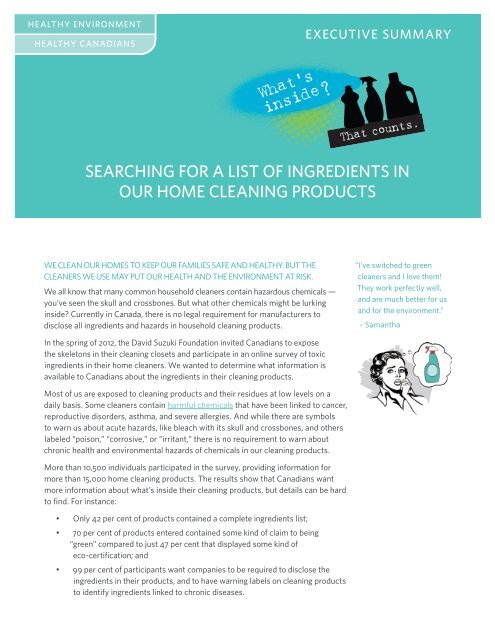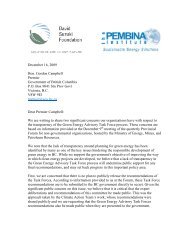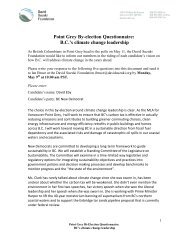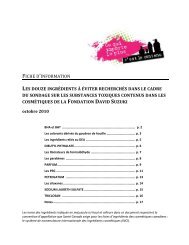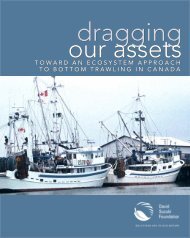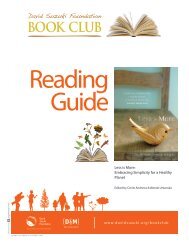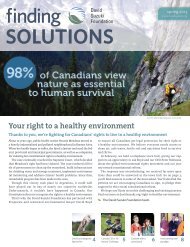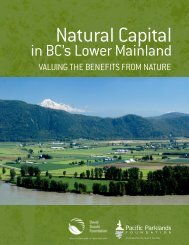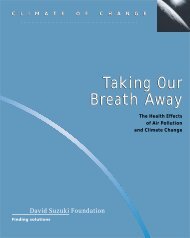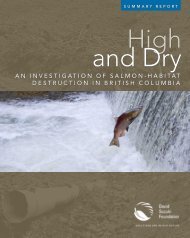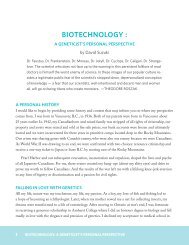Download PDF - David Suzuki Foundation
Download PDF - David Suzuki Foundation
Download PDF - David Suzuki Foundation
- No tags were found...
Create successful ePaper yourself
Turn your PDF publications into a flip-book with our unique Google optimized e-Paper software.
HEALTHY ENVIRONMENTHEALTHY CANADIANSEXECUTIVE SUMMARY.SEARCHING FOR A LIST OF INGREDIENTS INOUR HOME CLEANING PRODUCTSWE CLEAN OUR HOMES TO KEEP OUR FAMILIES SAFE AND HEALTHY. BUT THECLEANERS WE USE MAY PUT OUR HEALTH AND THE ENVIRONMENT AT RISK.We all know that many common household cleaners contain hazardous chemicals —you’ve seen the skull and crossbones. But what other chemicals might be lurkinginside? Currently in Canada, there is no legal requirement for manufacturers todisclose all ingredients and hazards in household cleaning products.“I’ve switched to greencleaners and I love them!They work perfectly well,and are much better for usand for the environment.”~ SamanthaIn the spring of 2012, the <strong>David</strong> <strong>Suzuki</strong> <strong>Foundation</strong> invited Canadians to exposethe skeletons in their cleaning closets and participate in an online survey of toxicingredients in their home cleaners. We wanted to determine what information isavailable to Canadians about the ingredients in their cleaning products.Most of us are exposed to cleaning products and their residues at low levels on adaily basis. Some cleaners contain harmful chemicals that have been linked to cancer,reproductive disorders, asthma, and severe allergies. And while there are symbolsto warn us about acute hazards, like bleach with its skull and crossbones, and otherslabeled “poison,” “corrosive,” or “irritant,” there is no requirement to warn aboutchronic health and environmental hazards of chemicals in our cleaning products.More than 10,500 individuals participated in the survey, providing information formore than 15,000 home cleaning products. The results show that Canadians wantmore information about what’s inside their cleaning products, but details can be hardto find. For instance:• Only 42 per cent of products contained a complete ingredients list;• 70 per cent of products entered contained some kind of claim to being“green” compared to just 47 per cent that displayed some kind ofeco-certification; and• 99 per cent of participants want companies to be required to disclose theingredients in their products, and to have warning labels on cleaning productsto identify ingredients linked to chronic diseases.
“I want to know that whatI’m using to clean is 100per cent safe. I think asconsumers we have theright to know what weare buying.”~ AngelaThere are third-body eco-certifications in Canada that help companies becomeofficially recognized as “green.” For example, EcoLogo® grants their seal of approvalafter reviewing and auditing the operations and products of various companies thatmeet specified requirements. Third-party certification helps standardize productswith an environmental claim so that consumers can trust the brands they purchase.Products that don’t bear these seals of approval may not meet all of the standards setout by third-party certification, and may include ingredients that are harmful to ourhealth and the environment, despite claims of being “green.”Better labelling isn’t unreasonable. Canada’s Cosmetic Regulations require thatingredients in personal care products must be on the label in a standard format.Shouldn’t the same, enforceable requirements apply to the products you use to cleanthe home where your family eats, plays, bathes, and sleeps?RecommendationsThe <strong>David</strong> <strong>Suzuki</strong> <strong>Foundation</strong> offers the following recommendations to protectour health and the health of our environment from unnecessary exposure to toxicchemicals in household cleaners:1. Break up with harmful household cleaners. Safely dispose of yourhousehold hazardous wastes (HHW), and replace them with some of theQueen of Green’s healthy cleaning alternatives.2. Read labels carefully. Don’t buy products that list “parfum” or “fragrance,”as these have been linked to chronic allergies.3. Follow Europe’s lead and develop a new labelling system in Canada thatincludes warnings about chronic and environmental health hazards, becauseeven small quantities of hazardous substances can accumulate over time toreach dangerous levels and contaminate the air, water, and soil.4. Require manufacturers to list ingredients in a consistent format so thatchemicals of concern can be easily identified.5. Restrict use of the terms “natural” and “organic” in the marketing ofproducts that contain non-organic and synthetic ingredients.6. Look for third-party certification on products making environmental or”green” claims.Take action by sending a letter to Canada’s Health Minister,calling on the federal government to get moving on productlabelling by visiting http://action.davidsuzuki.org/comeclean.Learn more about homecleaners at davidsuzuki.org
A home cleaner labelshould include:1 A third-party certified eco-label2 Official biodegradability designationBIODEGRADABLEE.G., BIODEGRADABLE TESTOECD 301 D OR E 3INGREDIENTS: E.G., ALKYLPOLYGLUCOSIDES (COCONUT),ROSMARIUNUS OFFICINALIS(ROSEMARY/ROMARIN) LEAF OIL, ETC.A complete and specific ingredient list withfull disclosure of chemical namesDisclosure of whatʼs inside “parfum” or “fragrance”CLEAN PRODUCT123 TRANSPARENCY DRIVEPRODUCT@CLEANPRODUCT.CLEANWWW.CLEANPRODUCT.CLEAN1.800.555.0000Company contact informationLearn more about homecleaners at davidsuzuki.org


